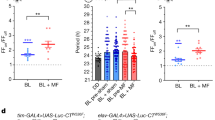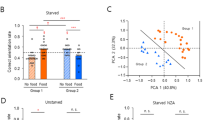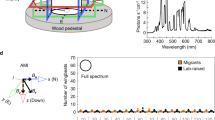Abstract
THE mechanism used by animals for geomagnetic field detection has long been discussed1. Leask2 has proposed that sensitivity to magnetic field might result from polarised light detection through optical pumping into the lowest level triplet state of (say) the rhodopsin molecule that possesses spin. Light detection, he suggests, might be a prerequisite for magnetic field detection and might result in an axial rather than a polar response in the animal. However, a unimodal reaction has been found3 with Tenebrio molitor L., the flour-beetle, in a horizontally directed magnetic field and a light field without directional features. This result was obtained when Tenebrio had been allowed to associate the geomagnetic field with the directional properties of the anisotropic light field in the culture container. The preferential direction in the horizontally directed magnetic field could be predicted from the ‘dark direction’ and from the relative humidity in the container (ref. 3, expt 43, page 429). I report here that Tenebrio and Talitrus saltator Mont., the sandhopper, can orientate in the Earth's magnetic field in complete darkness, and that in Tenebrio this orientation is essentially polar, not axial. These results are evidence that these two invertebrates do not require light for the detection of the magnetic field.
This is a preview of subscription content, access via your institution
Access options
Subscribe to this journal
Receive 51 print issues and online access
$199.00 per year
only $3.90 per issue
Buy this article
- Purchase on Springer Link
- Instant access to full article PDF
Prices may be subject to local taxes which are calculated during checkout
Similar content being viewed by others
References
Viguier, C. Rev. Phil. 14, 1–36 (1882).
Leask, M. J. M. Nature 267, 144–145 (1977).
Arendse, M. C. & Vrins, J. C. M. Neth. J. Zool. 25, 407–437 (1975).
Batschelet, E. in Animal Orientation and Certain Biological Rhythms (American Institute of Biological Science, Washington, D. C., 1965).
Wiltschko, W. & Wiltschko, R. Science 176, 62–64 (1972).
Leask, M. J. M. (personal communication).
Howland, H. C. Z Tierpsychol. 33, 295–312 (1973).
Wallraff, H. G. Z. Tierpsychol. 33, 313–318 (1973).
Mardia, K. V. Statistics of Directional Data (Academic, London, 1972).
Reille, A. J. Physiol., Paris 60, 85–92 (1968).
Kreithen, M. L. & Keeton, W. T. J. comp. Physiol. 91, 355–362 (1974).
Bookman, M. A. Nature 267, 340–342 (1977).
Emlen, S. T. et al. Science 193, 505–508 (1976).
Wiltschko, W. in Animal Orientation and Navigation (NASA SP-262), (U. S. Government Printing Office, Washington, 1972).
Kalmijn, A. J. in Abstr. Symp, Animal Migration Navigation Homing, Tübingen (1977).
Keeton, W. T. Adv. Study Behav. 5, 47–132 (1974).
Ercolini, A. & Scapini, F. Mon. zool. ital. (N.S.) 6, 75–84 (1972).
Scapini, F. & Ercolini, A. Mon. zool. ital. (N.S.) suppl. V, 23–30 (1973).
Perttunen, V. & Lahermaa, M. Ann. Ent. Fenn. 29, 83–106 (1963).
Verheijen, F. J. & Brouwer, J. M. M. Verh. J. Zool. 22, 72–80 (1972).
Author information
Authors and Affiliations
Rights and permissions
About this article
Cite this article
ARENDSE, M. Magnetic field detection is distinct from light detection in the invertebrates Tenebrio and Talitrus. Nature 274, 358–362 (1978). https://doi.org/10.1038/274358a0
Received:
Accepted:
Issue Date:
DOI: https://doi.org/10.1038/274358a0
This article is cited by
-
Honey bees possess a polarity-sensitive magnetoreceptor
Journal of Comparative Physiology A (2017)
-
Tenebrio beetles use magnetic inclination compass
Naturwissenschaften (2008)
-
Equatorial sandhoppers use body scans to detect the earth’s magnetic field
Journal of Comparative Physiology A (2006)
-
Magneto reception: Why is conditioning so seldom successful?
Naturwissenschaften (1996)
-
Solar and landscape cues as orientation mechanisms in the beach-dwelling beetle Eurynebria complanata (Coleoptera, Carabidae)
Marine Biology (1994)
Comments
By submitting a comment you agree to abide by our Terms and Community Guidelines. If you find something abusive or that does not comply with our terms or guidelines please flag it as inappropriate.



